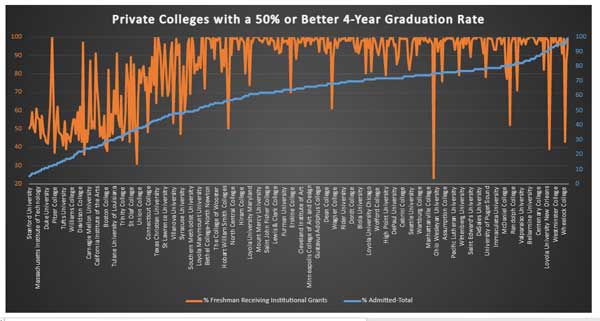 If you’re trying to figure out how to pay for college, if you’re looking for the best merit scholarship opportunities, you need to understand the basics of supply and demand in higher education. Why? Because we charge students to attend college. Granted, the way we pay for higher education is a complicated mixture of public finance and individual contributions but it’s still part of the market place. There’s a reason why colleges bury high school students in an avalanche of slick brochures and social media invitations–colleges are competing for students willing to pay to attend their version of the “collegiate experience.”
If you’re trying to figure out how to pay for college, if you’re looking for the best merit scholarship opportunities, you need to understand the basics of supply and demand in higher education. Why? Because we charge students to attend college. Granted, the way we pay for higher education is a complicated mixture of public finance and individual contributions but it’s still part of the market place. There’s a reason why colleges bury high school students in an avalanche of slick brochures and social media invitations–colleges are competing for students willing to pay to attend their version of the “collegiate experience.”
The sooner families recognize this, the sooner they can start targeting the schools most likely to provide the most generous merit awards. Because while it’s not an exact science, the laws of supply and demand provide a good indicator of where to look.
Supply of colleges
This really isn’t complicated. Let’s consider this from the student’s point of view. There is a supply of over 1,500 four-year colleges with 500 or more full-time undergraduates available in the United States. However, not all colleges are equal, for a variety of reasons some are more desirable than others. Therefore, more students apply to certain colleges than others. These colleges are in high demand by students.
Colleges in high demand have so many students applying, they can be more selective about who they accept. Stanford, Harvard, Princeton, Columbia, Yale, University of Chicago, MIT, CalTech, Brown, Pomona, and University of Pennsylvania accept 10% or less of applicants. Students who want to be accepted at these schools have to have the most exceptional qualifications because of the competition.
Popular colleges can charge for the privilege of attending
Now here’s the part of supply and demand that too many families just can’t seem to get past. The fact that these schools are in such high demand means that they don’t have to offer any incentives for students to attend. It means that they can charge students more to attend than other schools. In fact, they can charge more for the students just to apply.
Think about it. In 2016-17, all charge more than $60,000, the University of Chicago was over $70,000. The average for all private schools was $45,964. All but two charged $75 or more just to apply compared to the $30 average for all private colleges. Why would these schools offer an academic or merit scholarship?
If nothing else, consider how would the college even award merit scholarships when everyone is so obviously qualified?
The answer is that for all intents and purposes, they don’t. Yes, some schools such as Stanford or Duke offer a small percentage of students merit scholarships. But your chances of getting one are even slimmer than getting accepted in the first place.
Low acceptance rates = scarcity
So here’s the first law of supply and demand for paying for college: as acceptance rates decrease, the cost of the college increases. This is because prestigious, in-demand colleges that have their pick of exceptionally qualified students can and do charge a premium to attend their institution. They are not offering generous merit awards to their students–they don’t have to.
Which colleges offer scholarships?
However, colleges that don’t have their pick of students have to offer financial incentives for them to attend. They are much more likely to offer merit scholarships for academic qualifications. And often those academic qualifications don’t even have to be “exceptional”–more on that in a future post.
For those who like numbers, take a look at the following graph of private colleges with a 50% or better four-year graduation rate. The blue line shows the acceptance rate. The orange line shows the percentage of freshman receiving institutional aid. The institutional aid can be need-based or merit-based.
Of the 299 colleges that admit 40% or more of its applicants, 242 provide 90% or more of freshman with institutional aid. The average is 93% for all 299 schools.
Among the 83 colleges that accept less than 40% of students, only four provide 90% or more of freshman with institutional grants. At 37 of these schools, 50% or fewer of freshman receive any institutional aid.
Name recognition costs
Now don’t start thinking that this means up to half of the students are getting merit aid which doesn’t seem that bad. The reality is that the vast majority of this money is actually need-based aid. These colleges do give students money but only based on need. In fact, most of these schools claim to meet 100% of financial need.
The reality is that if you want to pay less for college, you need to start shopping at schools you’ve probably never heard of.
Next week: What Do Rankings Have To Do With It?




9 thoughts on “How to Pay Less for College: Understand Supply and Demand”